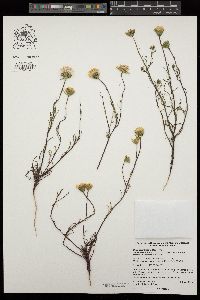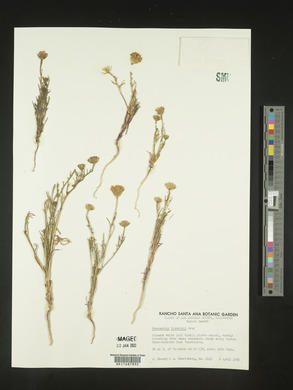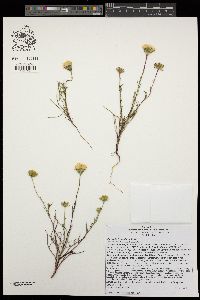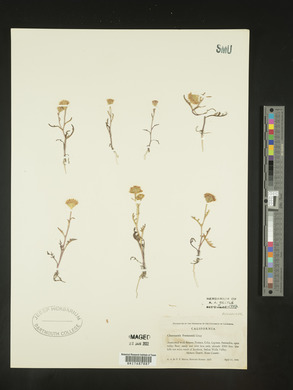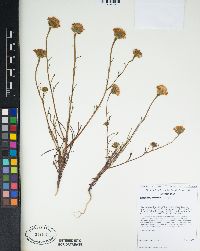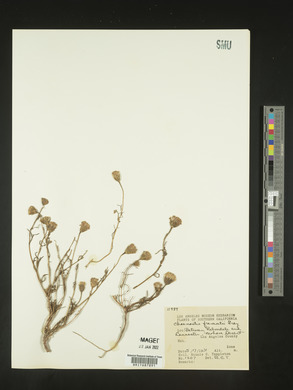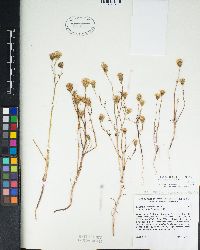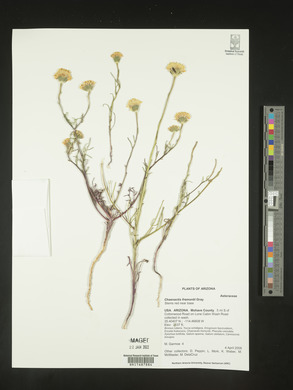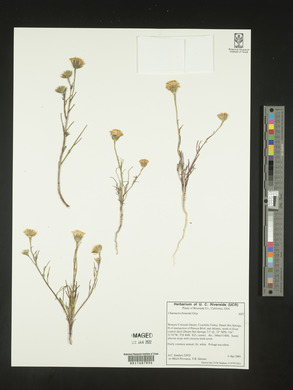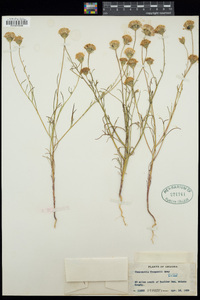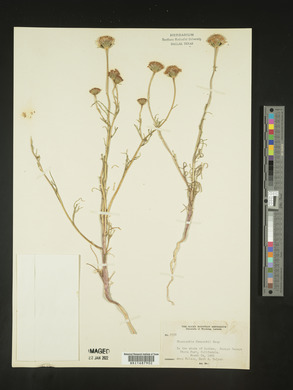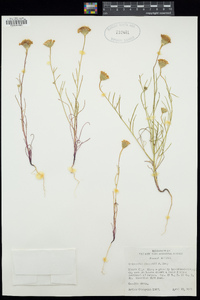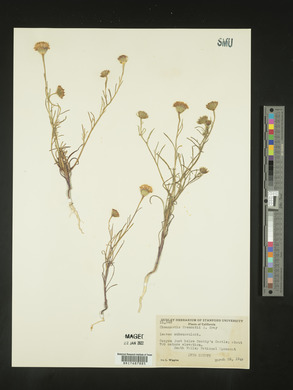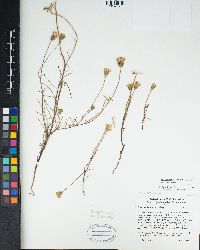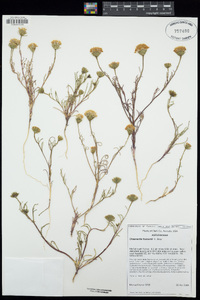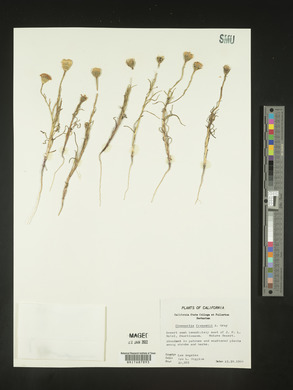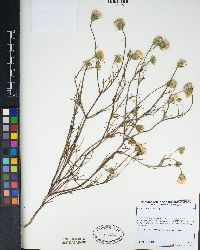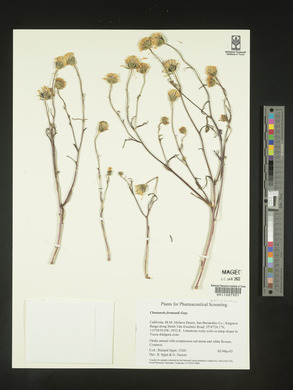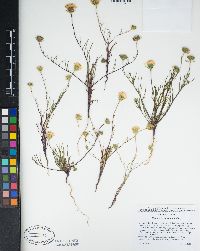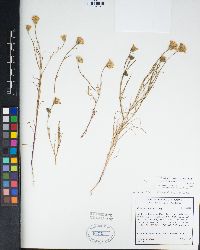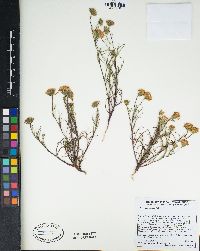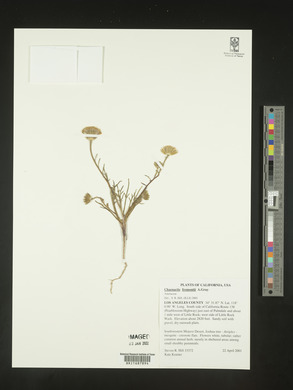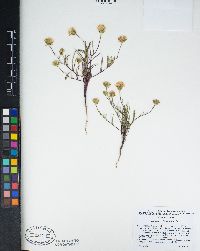Chaenactis fremontii
|
|
|
|
Family: Asteraceae
Morningbride, more...pincushion flower, Fremont's pincushion
|
Plants 10-30(-40) cm; proximal indument glabrescent (early ± arachnoid, glabrous by flowering). Stems mostly 1-12; branches mainly proximal. Leaves basal (withering) and ± cauline, 1-7(-10) cm; largest blades linear and terete or ± elliptic and plane, ± succulent, 0-1-pinnately lobed; lobes 1-2(-5) pairs, remote, ± terete. Heads (± radiant) mostly 1-5 per stem. Peduncles 2-8(-10) cm, distally usually ± stipitate-glandular and, sometimes, ± arachnoid (at least early, often glabrescent by fruit). Involucres ± hemispheric to obconic (bases pale and ± truncate in fruit). Phyllaries: longest 8-10(-12) mm; outer usually glabrescent in fruit, apices erect, acute, ± rigid. Florets: corollas white to pinkish, 5-8 mm (inner); peripheral corollas spreading, zygomorphic, enlarged. Cypselae (3-)6-8 mm; pappi of (1-)4(-5) scales in 1 series, longest scales 6-8.5 mm, lengths 1-1.3 times corollas (apices visible among corollas at flowering). 2n = 10. Flowering Mar-May. Sandy or gravelly soils, warm deserts, often growing through shrubs; -10-1600 m; Ariz., Calif., Nev., Utah; Mexico (Baja California). Chaenactis fremontii is often the most abundant spring wildflower in the lower Mojave and northern Sonoran deserts, where it is reported to be a significant food source for desert tortoises (Gopherus agassizii Cooper). It also extends seaward into the southern San Joaquin Valley area of west-central California, often as hybrids with other taxa (see sectional discussion). The involucre bases described above are characteristic of Chaenactis fremontii and can help separate it from some forms of C. stevioides.
FNA 2006 Duration: Annual Nativity: Native Lifeform: Forb/Herb General: Annual herbs, 10-40 cm tall; stems 1-12 per plant, branching close to the ground. Leaves: Basal leaves early-withering; stem leaves alternate; blades 1-10 cm long, often terete, linear or pinnately lobed, with up to 5 pairs of lobes. Flowers: Flower heads white, radiant, mostly 1-5 per stem, on peduncles 2-10 cm long, these usually stipitate-glandular and sometimes arachnoid; involucre (ring of bracts wrapped around the flower head hemispheric to obconic, the bases pale and truncate in fruit; involucral bracts (phyllaries) up to 8-12 mm long; outer phyllaries usually glabrescent in fruit, with erect, acute, rigid tips; inner (disc) florets 5-8 mm high, the corollas white to pinkish; outer ring of florets zygomorphic, the corolla with an enlarged, spreading 5-lobed lip. Fruits: Achenes 6-8 mm long, topped with a pappus of 1-5 (usually 4) scales, the longest scales 6-9 mm long, extending above tops of corollas during flowering. Ecology: Found on sandy or gravelly soils, in warm deserts, often growing through shrubs, below 5,500 ft (1676 m); flowers March-May. Distribution: AZ, CA, NV, UT; south to n MEX (Baja California). Notes: Chaenactis fremontii is often the most abundant spring wildflower in the lower Mojave and northern Sonoran deserts, where it is reported to be a significant food source for desert tortoises. This white-flowered annual herb is quite similar to the more widespread C. stevioides, but that species has shorter pappus scales on the achenes, which do not extend beyond the corolla tips during flowering; it is more likely to have long, silver, cobwebby hairs, especially on the lower parts of the stems; the leaves are 1-2 times pinnately lobed (unlobed or only 1 time pinnately lobed in C. fremontii); and the outer phyllaries are blunt-tipped and covered with gland-tipped hairs when the plant is fruiting (C. fremontii has phyllaries with pointed tips which are nearly hairless in fruit. Ethnobotany: Unknown, but other species in the genus have uses. Synonyms: None Editor: AHazelton 2015 Etymology: Chaenactis is from the Greek chaino, to gape and aktis, ray, referring to the enlarged corollas; fremontii honors John Charles Fremont (1813-1890), "the Pathfinder," Army officer and presidential candidate who collected plants on four hazardous journeys exploring the western United States. |







